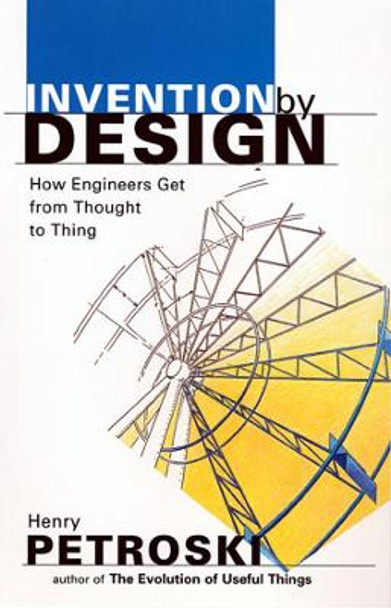Description
Henry Petroski's previous bestsellers have delighted readers with intriguing stories about the engineering marvels around us, from the lowly pencil to the soaring suspension bridge. In this book, Petroski delves deeper into the mystery of invention, to explore what everyday artifacts and sophisticated networks can reveal about the way engineers solve problems.
Engineering entails more than knowing the way things work. What do economics and ecology, aesthetics and ethics, have to do with the shape of a paper clip, the tab of a beverage can, the cabin design of a turbojet, or the course of a river? How do the idiosyncrasies of individual engineers, companies, and communities leave their mark on projects from Velcro (R) to fax machines to waterworks? Invention by Design offers an insider's look at these political and cultural dimensions of design and development, production and construction.
Readers unfamiliar with engineering will find Petroski's enthusiasm contagious, whether the topic is the genesis of the Ziploc (R) baggie or the averted collapse of Manhattan's sleekest skyscraper. And those who inhabit the world of engineering will discover insights to challenge their customary perspective, whether their work involves failure analysis, systems design, or public relations. Written with the flair that readers have come to expect from his books, Invention by Design reaffirms Petroski as the master explicator of the principles and processes that turn thoughts into the many things that define our made world.
Henry Petroski does it again: bringing engineering to life. Engineering design is a very human activity, with social and cultural factors playing as much a role as science and mechanics. Nobody tells the story better than Petroski, with his meticulously researched case histories of objects that range from the small and ordinary to the large and complex. Our understanding of design is, once again, made richer and more profound. -- Donald A. Norman, Vice President, Apple Computer, and author of Things That Make Us Smart Magicians are famous for keeping their 'tricks' a secret. Inventors and engineers are often thought to have the same attitude about their often remarkable technological achievements. Ask a person on the street how zippers, pop-top aluminum cans, or fax machines work, and you're likely to get a shrug and an anguished admission: 'I don't even know how to program my VCR.' At last, the always enlightening--and entertaining--Henry Petroski explains many of the more confounding technological riddles of modern life in Invention by Design. This is a delightful book and a 'must read' for anyone who wants to know how the modern world got to be the way it is. -- Norman R. Augustine, President and CEO, Lockheed Martin Corporation Whales and parrots host large, rapidly evolving vocal traditions. Beavers and termites construct elaborate artifacts. Humans alone combine these two facilities to rapidly evolve artifacts. Engineering may be the most uniquely human endeavor. Petroski's compelling new book raises our consciousness to this truth, with case studies ranging from the gripping story of paper clips to the elevating tale of skyscrapers. Also here is a hint of things to come, as our artifacts play an ever greater role in their own evolution. -- Hans Moravec, author of Mind Children: The Future of Robot and Human Intelligence (Harvard) Through fascinating case histories, Henry Petroski has vividly depicted the qualitative side of engineering and in doing so has shown me that my work (especially in the area of product design) is often akin to engineering, while what engineers do is often also--no question about it--art. Though the problems that engineers and inventors set out to solve may be different from those of other design specialists, Invention by Design proves that the many design decisions in which engineers are involved are as heavily influenced by the intangibly aesthetic as by the purely functional. Mr. Petroski demonstrates in this well-rounded, accessible volume that great engineers, like all designers, are driven by the desire to improve the human condition, whatever the tools they use. -- Michael Graves, Architect
About the Author
Henry Petroski was the Aleksandar S. Vesic Distinguished Professor Emeritus of Civil and Environmental Engineering at Duke University.
Reviews
The technical aspects of [Petroski's] stories are very appealing. To see a pencil as a cantilever beam or a beverage can as a pressure vessel is to feel the power of engineering insight. -- David Jones * Nature *
People who think engineering is a bore have never read anything by Henry Petroski. A professor of civil engineering and history at Duke University, Petroski is notable for writing an entire book about pencils...and making the whole 400 pages completely fascinating. His newest book, which proclaims itself as showing 'how engineers get from thought to thing,' is equally interesting... Invention by Design uses 10 short case studies to introduce some of the discipline's salient principles and techniques... Readers end up with a wonderful accumulation of fun facts... Such details do more than entertain. They show how engineers work and emphasize how engineers must go beyond design and analysis to consider the risks and consequences of a product's failure, ensure quality control, minimize costs and satisfy the dictates of aesthetics, politics and social attitudes. -- John R. Alden * Cleveland Plain Dealer *
This is a delightful book to read. Ostensibly written for intelligent laypersons to give some understanding of how we got to the technological world in which we now live, it will probably be read and enjoyed as much or even more by engineering and product designers. -- Peter J. Booker * Engineering Designer *
Petroski light-heartedly though soundly exposes the so-called engineer's thinking, which from its position within the field of science and technology is more concerned with designing than with calculating. The book makes elegant connections between the design features of a variety of 'engineering products.' These are discussed in the most natural-seeming of series; from paper clip, pencil and zipper, via problems of water and air transport, to designs for bridges and skyscrapers. The reader is, as it were, trained to be an inquisitive designer. Scattered throughout the book are brief mental exercises in the shape of entertaining questions regarding designed details of the real world (Why are ashtrays in aircraft glued shut? What structural precautions need to be taken if a complete oil platform, whose length is greater than the height of the highest building in the world, is to be moved from a horizontal to a vertical position?) This arrangement explains why the book is required reading for many a student. But Petroski also achieves the necessary depth whenever he explains in detail the principles and processes which lie behind existing and widely known products... [Invention by Design] does comprise an outstanding source of knowledge and inspiration as much about history as about design approaches. -- Marc Maurer * Archis [The Netherlands] *
Invention by Design should be required reading for all present and future engineers. -- Dennis J. Fallon * ASEE Prism *
If in Invention by Design Henry Petroski doesn't quite endow engineers with all the nobility and cachet of the artist, he does make the products of their work-the beer cans from which we drink, the airplanes in which we fly-the interesting things they truly are. Each of these-along with the paper clip, pencil, zipper, fax machine, water-supply system, bridge and skyscraper-Petroski honors with a heavily illustrated chapter, each a glimpse into the workings of engineering design... [Petroski] tells a good story. -- Robert Kanigal * Civilization *
[A] lucid and lively book... Whether designing something as small as a pencil or as large as the World Trade Center, successful engineers must not only devise new technology but also find a way to situate that technology within the existing economic, social, and ecological order. Every case study includes well-chosen pictures and schematic drawings to clarify how inventors resolve technical difficulties, and the carefully researched text explains how they make their new creations economically feasible and socially acceptable. Students of technology will delight in one part of the book, cultural historians in another, but both groups will praise the author. -- Bryce Christensen * Booklist *
Petroski is, essentially, a cheerleader for civil engineers, who are at their most successful when their designs blend so completely into our environment that we forget about the magnificent achievements they represent. Here Petroski takes a look at the development of such things as pencils, zippers, paper clips, the fax machine, turbojet aircraft, suspension bridges, aluminum beverage cans, and the systems that heat and cool modern buildings... [A] pleasant, readable, and persuasive [book]. * Kirkus Reviews *
Petroski...has done much to make the nerdy world of engineering interesting and accessible to the reader. Here, he's after a difference audience, one interested in the philosophy and cultural study of the process of invention... This book is engaging... [It's] good reading for those interested in the gestalt of engineering design. * Library Journal *
Magicians are famous for keeping their 'tricks' a secret. Inventors and engineers are often thought to have the same attitude about their often remarkable technological achievements. Ask a person on the street how zippers, pop-top aluminum cans, or fax machines work, and you're likely to get a shrug and an anguished admission: 'I don't even know how to program my VCR.' At last, the always enlightening-and entertaining-Henry Petroski explains many of the more confounding technological riddles of modern life in Invention by Design. This is a delightful book and a 'must read' for anyone who wants to know how the modern world got to be the way it is. -- Norman R. Augustine, President and CEO, Lockheed Martin Corporation
Through fascinating case histories, Henry Petroski has vividly depicted the qualitative side of engineering and in doing so has shown me that my work (especially in the area of product design) is often akin to engineering, while what engineers do is often also-no question about it-art. Though the problems that engineers and inventors set out to solve may be different from those of other design specialists, Invention by Design proves that the many design decisions in which engineers are involved are as heavily influenced by the intangibly aesthetic as by the purely functional. Mr. Petroski demonstrates in this well-rounded, accessible volume that great engineers, like all designers, are driven by the desire to improve the human condition, whatever the tools they use. -- Michael Graves, architect
Whales and parrots host large, rapidly evolving vocal traditions. Beavers and termites construct elaborate artifacts. Humans alone combine these two facilities to rapidly evolve artifacts. Engineering may be the most uniquely human endeavor. Petroski's compelling new book raises our consciousness to this truth, with case studies ranging from the gripping story of paper clips to the elevating tale of skyscrapers. Also here is a hint of things to come, as our artifacts play an ever greater role in their own evolution. -- Hans Moravec, author of Mind Children: The Future of Robot and Human Intelligence
Henry Petroski does it again: bringing engineering to life. Engineering design is a very human activity, with social and cultural factors playing as much a role as science and mechanics. Nobody tells the story better than Petroski, with his meticulously researched case histories of objects that range from the small and ordinary to the large and complex. Our understanding of design is, once again, made richer and more profound. -- Donald A. Norman, Vice President, Apple Computer, and author of Things That Make Us Smart
Book Information
ISBN 9780674463684
Author Henry Petroski
Format Paperback
Page Count 256
Imprint Harvard University Press
Publisher Harvard University Press
Weight(grams) 354g






